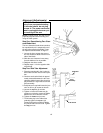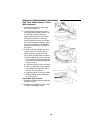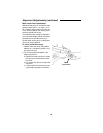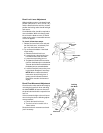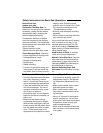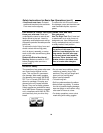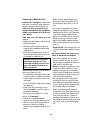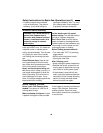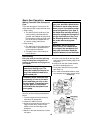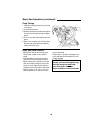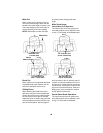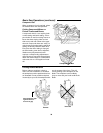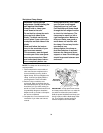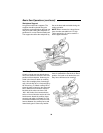
25
Preparing to Make the Cut
Inspect Your Workpiece. Make sure
there are no nails or foreign objects in
the part of the workpiece to be cut.
Plan your work to avoid thrown
pieces caused when the workpiece
binds on the blade and is torn from
your hands.
Plan how you will make the cut.
Always:
• Make sure the blade is not spinning.
• Raise the blade.
• Slide the saw out above the front
edge of the workpiece before start-
ing saw, and
• Push the sawblade down on top of
the wood and back toward the rear
of the saw to make the cut.
DANGER: NEVER pull the saw
toward you during a cut. The
blade can suddenly climb up on
top of the workpiece and force
itself toward you.
Plan the way you will hold the work-
piece from start to finish.
• Avoid awkward operations and hand
positions where a sudden slip could
cause fingers or hand to move into
the blade.
• Don’t Overreach. Keep good footing
and balance.
• Keep your face and body to one
side of sawblade, out of line with a
possible throwback.
• Cut only one workpiece at a time.
Never cut Freehand:
• Brace your workpiece solidly
against the fence and table top so it
will not rock or twist during the cut.
• Make sure there’s no debris
between the workpiece and its sup-
ports.
• Make sure no gaps between the
workpiece, fence and table will let
the workpiece shift after it is cut in
two.
• Cut only one workpiece at a time.
• Keep the cut off piece free to move
sideways after it's cut off. Otherwise,
it could get wedged against the
blade and could be thrown violently.
• Clear everything except the work-
piece and related support devises
off the table before turning the miter
saw on.
• Secure Work. Use clamps or a vise
to help hold the work when it’s prac-
tical.
Use extra caution with large, very
small or awkward workpieces:
• Use extra supports (tables, saw
horses, blocks, etc.) for any work-
pieces large enough to tip when not
held down to the table top.
• Never use another person as a sub-
stitute for a table extension, or as
additional support for a workpiece
that is longer or wider than the basic
miter saw table or to help feed, sup-
port or pull the workpiece.
• Do not use this saw to cut pieces
too small to let you easily hold the
work while you keep the thumb side
of your index (pointer) finger against
the outside edge of the fence.
• When cutting irregularly shaped
workpieces, plan your work so it will
not slip and pinch the blade and be
torn from your hands. A piece of
molding, for example, must lie flat or
be held by a fixture or jig that will not
let it twist, rock or slip while being
cut.



